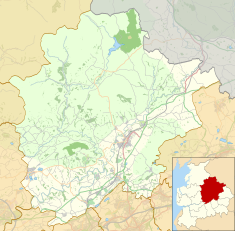Clitheroe castle
| Clitheroe Castle | |
|---|---|

The keep at Clitheroe Castle, August 2007
|
|
| Location | Clitheroe, Lancashire |
| Coordinates | 53°52′15″N 2°23′35″W / 53.8709°N 2.3931°WCoordinates: 53°52′15″N 2°23′35″W / 53.8709°N 2.3931°W |
| OS grid reference | SD 742416 |
| Built | 12th century |
| Built for | de Lacy family |
| Designated | 10 April 1915 |
| Reference no. | 1016196 |
|
Listed Building – Grade I
|
|
| Designated | 19 May 1950 |
| Reference no. | 1071553 |
Clitheroe Castle is a ruined early medieval castle in Clitheroe in Lancashire, England. It was the caput of the Honour of Clitheroe, a vast estate stretching along the western side of the Pennines.
Its earliest history is debated but it is thought to be of Norman origin, probably built in the twelfth century. Property of the de Lacy family, the honour later merged with the earldom and then Duchy of Lancaster. Given to George Monck, 1st Duke of Albemarle in 1660, the castle site remained in private ownership until 1920, when it was sold to the people of Clitheroe to create a war memorial. Today the buildings on the site are the home of Clitheroe Castle Museum.
The keep is the second smallest surviving stone-built keep in England. The castle was listed as a Scheduled Monument on 10 April 1915 (and later, under the Ancient Monuments and Archaeological Areas Act 1979 law). It was Grade I listed on 19 May 1950.
After the Norman conquest, the Anglo-Saxon hundred of Blackburnshire was part of a fief given to Roger de Poitou and the Domesday survey shows he had given it to Roger de Busli and Albert de Gresle. Clitheroe is not mentioned by name, and it is assumed that Blackburn had previously been the administrative centre. However sometime during the reign of William Rufus, Poitou gave Blackburnshire and the Bowland area, north of the River Ribble (under Craven in the Domesday Book) to the Baron of Pontefract, Robert de Lacy. When de Poitou lost his English holdings in 1102, Henry I not only allowed de Lacy to keep these lands, but added to them with the vills of Chipping, Aighton and Dutton.Clitheroe would become the centre of this new honour.
...
Wikipedia

